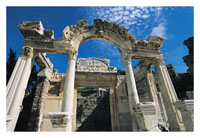 Driving from the pier through the Turkish countryside, you will arrive to the entrance to Ancient City of Ephesus that was built on a small hill, with the entrance located at the top of the hill and the exit at the bottom. Once you enter the Open Air Archeological Museum of Ephesus and pass by the Magnesia gate, you will enter the administrative section of ancient Ephesus. The guided walking tour will take you through one of the most magnificent excavations in the world. See the Odeon, the Fountain of Trajan, the steam baths of Scholastika, temple of Hadrian and the impressive library of Celsius. The library is adorned with columns and statues. The Grand Theater, where St. Paul preached, is one of the largest theaters in antiquity with a capacity of 24,000 seats. You will return to the buses through the Arcadian way, where Mark Anthony and Cleopatra once rode in procession. Driving from the pier through the Turkish countryside, you will arrive to the entrance to Ancient City of Ephesus that was built on a small hill, with the entrance located at the top of the hill and the exit at the bottom. Once you enter the Open Air Archeological Museum of Ephesus and pass by the Magnesia gate, you will enter the administrative section of ancient Ephesus. The guided walking tour will take you through one of the most magnificent excavations in the world. See the Odeon, the Fountain of Trajan, the steam baths of Scholastika, temple of Hadrian and the impressive library of Celsius. The library is adorned with columns and statues. The Grand Theater, where St. Paul preached, is one of the largest theaters in antiquity with a capacity of 24,000 seats. You will return to the buses through the Arcadian way, where Mark Anthony and Cleopatra once rode in procession.
Your next stop on the tour will be the city of Magnesia an ancient Greek city in Anatolia. The ancient city was founded by colonists from Thessalia, Greece. This is the ancient city where the name “magnet” comes from. Magnesia was an important location commercially and strategically in the triangle of Priene, Ephesus and Tralles. As an interesting note, Magnesia was the source for the mysterious stones that could attract or repel each other, and thus its name came to be used for the phenomenon known as magnetism.
Continuing on your tour you will reach the ancient site of Miletus, which was a great Ionian Port, with two lions guarding its entrance as important in antiquity as Ephesus and famous for being the native city of several philosophers and sages. The Theatre, reconstructed during the Roman period, is an impressive structure built against the slope of a hill. Together with the well preserved Faustina Baths they make up the only monument left from the ancient Miletus. You will continue to Didyma, to admire the magnificent Temple of Apollo, a great monument of antiquity. Some of the 120 columns that remain standing allow one to visualize the full magnificence of the structure. A typical lunch will be served in the town of “Didim” at a local restaurant, overhanging the ruins of the Temple of Didyma where you can taste the delicious samples of Turkish cuisine.
On completion of your visit, your bus will take you to Kusadasi. Join the group for a refreshment stop and a brief carpet presentation or return directly to the ship which is within walking distance.
 |